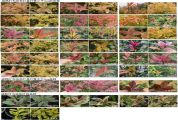 PDF(3898 KB)
PDF(3898 KB)


 PDF(3898 KB)
PDF(3898 KB)
 PDF(3898 KB)
PDF(3898 KB)
25个彩叶桂无性系(品种)的数量分类研究
Numerical classification of 25 color-leafed Osmanthus fragrans clones (cultivars)
 ,
,
 ,
,

【目的】通过观测彩叶桂品种的枝叶性状并进行数量分类研究,为彩叶桂品种分类和优良品种选育提供参考依据。【方法】于春季对25个彩叶桂品种进行形态学特征观察,以观测的35个枝叶性状指标数据进行R型聚类分析和主成分分析,去掉相关性较大且累积贡献率较小的性状指标,然后对25个彩叶桂品种进行Q型聚类分析。【结果】R型聚类结果显示:除彩叶桂叶面是否皱缩和侧脉是否隆起,叶片横切面与主脉凹凸度,叶柄颜色与新枝是否双色,成熟叶叶色、成熟叶有无花斑、幼叶色彩类型、叶片色彩类型、幼叶颜色和叶色有较明显的相关性外,各性状相对独立。主成分分析结果显示:共提取11个主成分,累计贡献率为87.618%,前9个主成分累计贡献率为81.157%,主要反映了彩叶桂各阶段色彩表现、叶大小、叶缘锯齿及叶面形态等。Q型聚类结果显示:25个彩叶桂品种按成熟叶叶色分为2大类,又由叶宽分为3类,最后根据叶宽、幼叶色彩类型、叶片横切面、叶形、叶片质地和叶脉色彩等分为10个组。【结论】R型聚类分析、主成分分析和Q型聚类分析表明,叶色、幼叶颜色、成熟叶叶色、叶型、叶面是否皱缩、叶片横切面、叶宽和叶形等性状可作为彩叶桂品种形态学分类的性状指标。综合而言,成熟叶叶色、叶片横切面和叶宽是此次数量分类得出的主要的标准和依据,但是否为该树种最主要的分类标准和依据还需进一步探讨和验证。
【Objective】 Numerical classification was carried out by observing the leaf and branch characteristics of Osmanthus fragrans cultivars. The results will provide a reference for their breeding and classification. 【Methods】 The morphological characteristics of 25 O. fragrans cultivars were observed in spring. Thirty-five leaf and branch characteristics were used for R-type clusters and a principal component analysis (PCA). After removing characteristics with a high correlation and low cumulative contribution, 35 characteristics were selected to conduct the classification of color-leafed O. fragrans colour cultivars with the Q-type cluster analysis. 【Results】 The R-type clusters showed that several variables (whether the leaf surface was wrinkled or not, whether the lateral veins were uplifted or not, petiole color, whether the new branches were dichromatic or not, the convex-concave degrees of the transverse section and the main vein of the leaves, and whether there were spotted blades on the mature leaves or not), were all significantly correlated with the color and color type at each stage of the leaves. All the other factors were relatively independent. The PCA showed that 11 principal components were extracted, their cumulative contribution was 87.618%. The cumulative contribution of the top nine principal components was 81.157%, mainly reflecting leaf colour representation in all stages, leaf size, serrated leaf margin, and leaf shape. The results of the Q-type cluster showed that the 25 O. fragrans cultivars were divided into the following: two categories based on the color of mature leaves; three categories based on average leaf width; and 10 categories according to the leaf width, the young leaf color type, leaf cross section, leaf shape, and leaf texture. 【Conclusion】 In general, the color of mature leaves, the cross section of the blade and the leaf width may be the most important criteria and the basis for the classification of color-leafed O. fragrans cultivars. However, this needs to be explored and verified.

彩叶桂 / 品种 / 数量分类 / 聚类分析 / 主成分分析
color-leafed Osmanthus fragrans / cultivar / numerical classification / clustering analysis / principal component analysis
| [1] |
向民, 段一凡, 向其柏. 木犀属品种国际登录中心年报(1) 彩叶桂品种群的建立[J]. 南京林业大学学报(自然科学版), 2014,38(1):2, 187.
|
| [2] |
冯园园, 李清莹, 胡绍庆. 彩叶桂品种资源与研究现状[J]. 浙江理工大学学报(自然科学版), 2019,36(6):793-798.
|
| [3] |
刘毅, 唐德瑞, 何佳林, 等. 陕西银杏主要栽培品种的数量分类研究[J]. 西北林学院学报, 2006,21(6):100-104.
|
| [4] |
杨如兴, 孔祥瑞, 张磊, 等. 茶树品种(品系)芽叶色泽表型遗传数量分类研究[J]. 热带亚热带植物学报, 2016,24(4):444-451.
|
| [5] |
郭林林, 宗成堃, 刘甜, 等. 丹参种质资源的数量分类研究[J]. 山东农业科学, 2014,46(5):55-59,2.
|
| [6] |
王玉蛟, 高岚, 杨勇, 等. 基于花色表型的芍药品种数量分类研究[J]. 北京林业大学学报, 2018,40(7):96-103.
|
| [7] |
赵喜萍, 李林, 魏朔南. 陕西漆树品种数量分类学研究[J]. 中国生漆, 2007,26(1):8-10.
|
| [8] |
赵小兰, 陈振锋. 武汉地区桂花品种的数量分类研究[J]. 湖北民族学院学报(自然科学版), 1998,16(6):3-5.
|
| [9] |
曾明颖. 四川省桂花品种数量分类研究[J]. 南方农业, 2009,3(2):68-70.
|
| [10] |
段一凡, 王贤荣, 梁丽丽, 等. 湖北咸宁桂花品种数量分类研究[J]. 湖北民族学院学报(自然科学版), 2010,28(3):289-293,301.
|
| [11] |
刘龙昌, 向其柏. 桂花品种数量分类研究[J]. 福建林学院学报, 2004,24(3):233-236.
|
| [12] |
唐东芹. 桂花品种数量分类研究[J]. 南京林业大学学报, 1998,22(1):3-5.
|
| [13] |
臧德奎, 向其柏, 季春峰. 柊树品种分类研究[J]. 南京林业大学学报(自然科学版), 2004,28(S1):58-64.
|
| [14] |
臧德奎. 桂花品种分类研究[D]. 南京:南京林业大学, 2004.
|
| [15] |
季春峰. 木犀属(Osmanthus)的系统分类学研究[D]. 南京:南京林业大学, 2004.
|
| [16] |
路飞. 桂花新品种DUS测试指南的研制[D]. 南京:南京林业大学, 2009.
|
| [17] |
李新蕊. 主成分分析、因子分析、聚类分析的比较与应用[J]. 山东教育学院学报, 2007,22(6):23-26.
|
| [18] |
|
| [19] |
郑玉红, 贾春, 顾永华, 等. 君子兰及其研究进展[J]. 北方园艺, 2012(19):189-195.
|
| [20] |
赵冰, 司国臣, 顾欣, 等. 秦岭秀雅杜鹃7个野生群体形态性状的变异分析[J]. 植物研究, 2012,32(5):561-566.
|
| [21] |
鲁涤非, 王其超. 桂花品种分类标准的探讨[J]. 华中农业大学学报, 1986,5(2):179-181.
|
| [22] |
刘玉莲. 南京地区桂花栽培品种调查研究[J]. 南京林业大学学报, 1985,9(1):30-37.
|
| [23] |
胡绍庆, 张后勇, 吴光洪, 等. 桂花品种分类系统研究[J]. 浙江大学学报(农业与生命科学版), 2005,31(4):95-98.
|
/
| 〈 |
|
〉 |